MERCURY
The closest planet to the Sun, Mercury (Figure 6-34) is a truly inhospitable world of temperature extremes. Its incredibly thin atmosphere and weak magnetic field leave it virtually unprotected from countless impacts and a continuous bath of deadly solar radiation. Despite having a surface nearly as dark as coal, Mercury sometimes appears as one of the brightest objects in our sky, due to its proximity to the Sun. We can see it from Earth only for a few hours before sunrise or a few hours after sunset because its angle from the Sun (its elongation) is always less than 28°. Because its orbit around the Sun is so elliptical, Mercury’s maximum elongation (see Figure 2-8c) ranges between 18° and 28°.
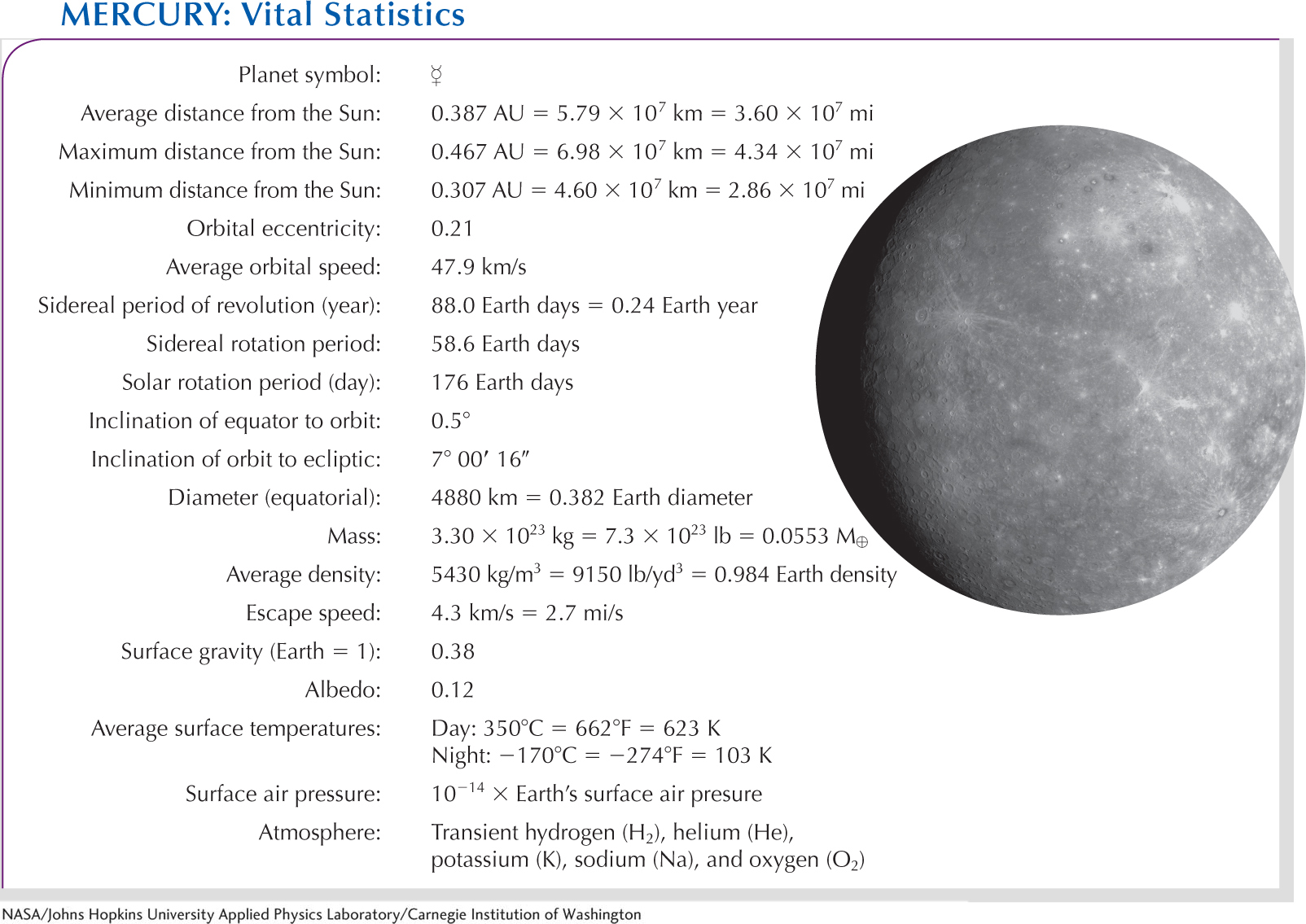
Figure 6-34 Mercury’s Vital Statistics NASA’s Mariner 10 spacecraft flew past heavily cratered Mercury 3 times in 1974 and 1975.The Messenger spacecraft has been orbiting Mercury since March 18, 2011. This image was taken by Messenger from an altitude of 27,000 km (17,000 mi).
6-11 Photographs from Mariner 10 and Messenger spacecraft reveal Mercury’s lunarlike surface
Until late last century, Mercury was a complete mystery. Earth-based telescopic studies provided virtually no information about the planet’s surface. The first spacecraft to visit it, Mariner 10, went by on three separate occasions, between March 1974 and March 1975, but only photographed 45% of Mercury’s surface. The images were tantalizing, showing the planet to be heavily cratered. The only other spacecraft to visit it, NASA’s Messenger, was put into orbit in 2011 and has imaged the rest of the planet. Messenger is short for MErcury Surface, Space, ENvironment, GEochemistry, and Ranging. It is also reminiscent of the historical Roman assignment of Mercury as the messenger of the gods.
First impressions of Mercury evoke a lunar landscape, and there are several similarities. Craters in the Moon’s highlands are densely packed, as are some of the craters on Mercury (Figure 6-35).Astronomers conclude that most of the craters on both Mercury and the Moon were produced by impacts in the first 800 million years after these bodies condensed from the solar nebula. The impact craters on both worlds have similar features, such as ejecta blankets and central peaks, as discussed for the Moon in Section 6-6. Unlike our Moon, however, Mercury also has a variety of volcanic craters out of which poured large amounts of lava that filled smaller impact craters and created smooth plains between larger ones (Figure 6-36). This volcanic activity may explain the high concentrations of sulfur-based compounds that Messenger has discovered on the planet’s surface. Like the Moon, Mercury has an exceptionally low albedo of 0.12 (its surface scatters 12% of incoming light). It is very bright as seen from Earth only because the sunlight scattering from Mercury is so intense.
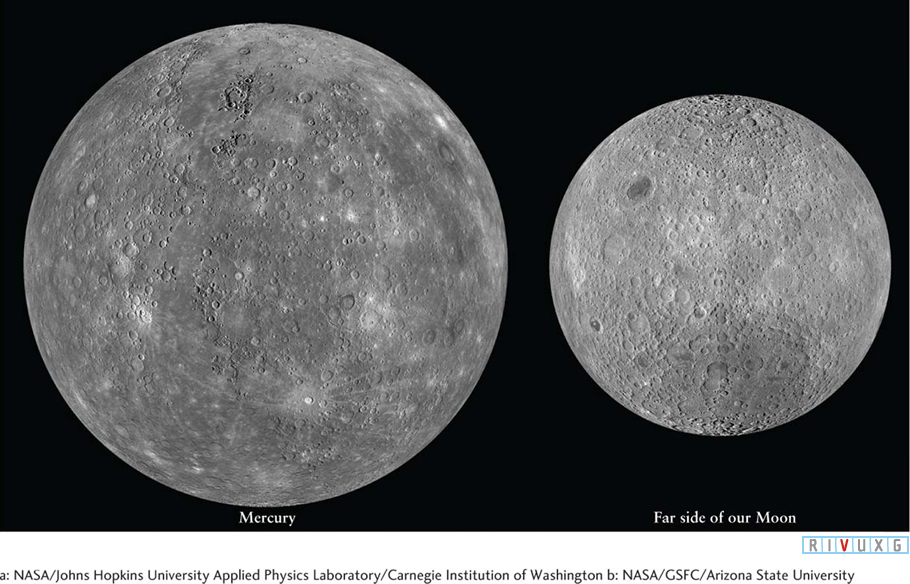
Figure 6-35  Mercury and the Far Side of Our Moon Mercury and our Moon are shown here to the same size scale. Mercury’s radius is 2439 km (1515 mi) and the Moon’s is 1738 km (1080 mi). For comparison, the distance from New York to Los Angeles is 3944 km (2451 mi). Mercury’s surface is more uniformly cratered than that of the Moon. Daytime temperatures at the equator on Mercury reach 700 K (800°F), hot enough to melt lead or tin.
Mercury and the Far Side of Our Moon Mercury and our Moon are shown here to the same size scale. Mercury’s radius is 2439 km (1515 mi) and the Moon’s is 1738 km (1080 mi). For comparison, the distance from New York to Los Angeles is 3944 km (2451 mi). Mercury’s surface is more uniformly cratered than that of the Moon. Daytime temperatures at the equator on Mercury reach 700 K (800°F), hot enough to melt lead or tin.
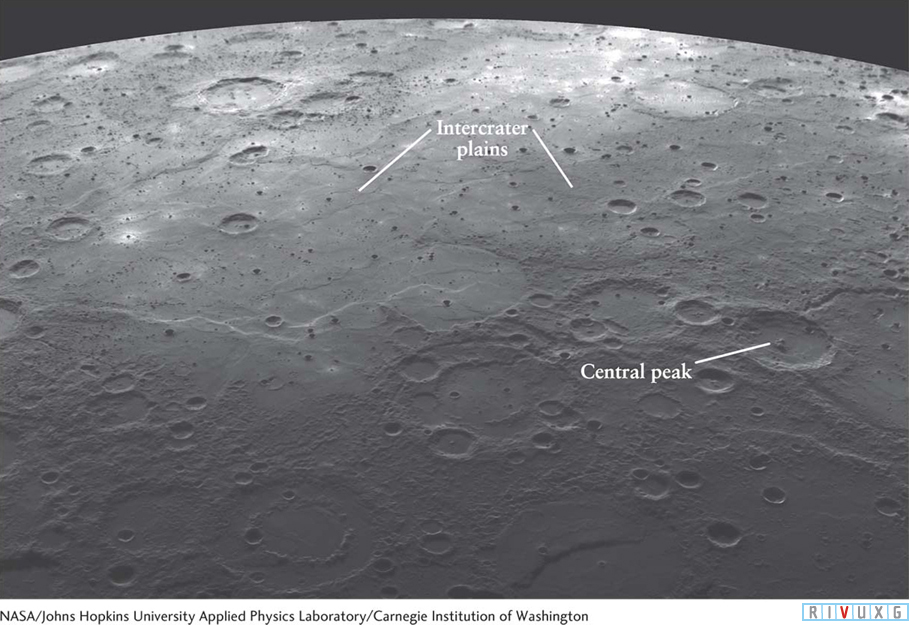
Figure 6-36  Mercury’s Craters and Plains This view of Mercury’s northern hemisphere was taken by Messenger as it sped past the planet in 2009. Numerous craters on the top left and bottom half of the image are separated by a broad intercrater plain created by lava flow from now extinct volcanoes. The image is about 880 km (550 mi) across.
Mercury’s Craters and Plains This view of Mercury’s northern hemisphere was taken by Messenger as it sped past the planet in 2009. Numerous craters on the top left and bottom half of the image are separated by a broad intercrater plain created by lava flow from now extinct volcanoes. The image is about 880 km (550 mi) across.
The most impressive feature discovered by Mariner 10 is a huge circular region called Caloris Basin. This name derives from caloris, Latin for “heat,” and in fact this feature is the closest part of Mercury to the Sun at the planet’s perihelion (closest approach to the Sun). Caloris Basin (Figure 6-37a) measures 1550 km (963 mi) in diameter, meaning that it has nearly 3 times the area of Texas. When viewed along the terminator (the border between day and night), where the shadows are longest and details clearest, the basin (Figure 6-37b) is seen to be surrounded by a 2-km-high (1.2-mi-high) ring of mountains, beyond which are relatively smooth plains. Like the lunar maria, Caloris Basin was probably gouged out by the impact of an asteroid that penetrated the planet’s crust. Messenger revealed small impact craters inside the Caloris Basin that have been filled in by lava from volcanoes that were active long after both the basin and those craters were formed. A giant volcano 95 km (59 mi) in diameter (bigger than the state of Delaware) has been seen in the basin.

Figure 6-37  Major Impacts on Mercury (a) Caloris Basin. Messenger sent back this view of a huge impact basin on Mercury’s equator. The basin is the entire orange-colored portion of the figure. This image has been color enhanced to show the different surface compositions of Mercury. The orange regions around the edge of the basin are believed to be volcanic features. (b) Only about half the Caloris Basin appears here because it happened to lie on the terminator when the Mariner 10 spacecraft sped past the planet. Although the center of the impact basin is hidden in the shadows (just beyond the left side of the picture), several semicircular rings of mountains reveal its extent. (c) Unusual, Hilly Terrain. What looks like tiny, fine-grained wrinkles on this picture are actually closely spaced hills, part of a jumbled terrain that covers nearly 500,000 km2 (193,000 mi2) on the opposite side of Mercury from the Caloris Basin. The large, smooth-floored crater, Petrarch, has a diameter of 170 km (106 mi). This impact crater was produced more recently than Caloris Basin.
Major Impacts on Mercury (a) Caloris Basin. Messenger sent back this view of a huge impact basin on Mercury’s equator. The basin is the entire orange-colored portion of the figure. This image has been color enhanced to show the different surface compositions of Mercury. The orange regions around the edge of the basin are believed to be volcanic features. (b) Only about half the Caloris Basin appears here because it happened to lie on the terminator when the Mariner 10 spacecraft sped past the planet. Although the center of the impact basin is hidden in the shadows (just beyond the left side of the picture), several semicircular rings of mountains reveal its extent. (c) Unusual, Hilly Terrain. What looks like tiny, fine-grained wrinkles on this picture are actually closely spaced hills, part of a jumbled terrain that covers nearly 500,000 km2 (193,000 mi2) on the opposite side of Mercury from the Caloris Basin. The large, smooth-floored crater, Petrarch, has a diameter of 170 km (106 mi). This impact crater was produced more recently than Caloris Basin.
The Caloris impact was a tumultuous event that shook the entire planet. Indeed, the collision affected the side of Mercury directly opposite the Caloris Basin (Figure 6-37c), which has a jumbled, hilly surface covering nearly half a million square kilometers (190,000 mi2) or about twice the size of Wyoming. The hills, which appear as tiny wrinkles that cover most of the photograph, are about 5 to 10 km (3 to 6 mi) wide and between 100 and 1800 m (110 and 1970 yd) high. Geologists believe that energy from the Caloris impact traveled through the planet and became focused, like light through a lens, as it passed through Mercury. As this concentrated energy reached the far surface of the planet, jumbled hills were pushed up. Similar pairs of phenomena to Caloris and the jumbled terrain on the other side of Mercury can be seen on our Moon. Both Mare Orientale and Mare Imbrium have chaotic hills on the opposite sides of the Moon from them. Finding such a similar pair of phenomena on a different world supports the connection between the impact and the jumbled surface.
Looking at Mercury in more detail, we start to see a variety of differences from the features on the Moon. Unlike our Moon’s maria, Mercury lacks extensive craterless regions. Instead, Mercury has broad plains dotted with relatively small craters (see Figure 6-36). Such plains are not found on the Moon. As we learned in Section 6-6, the lunar maria were produced by extensive lava flows into giant preexisting craters, flows that occurred between 3.1 and 3.8 billion years ago. The reason Mercury has no maria is that it lacked the giant craters from which to form them.
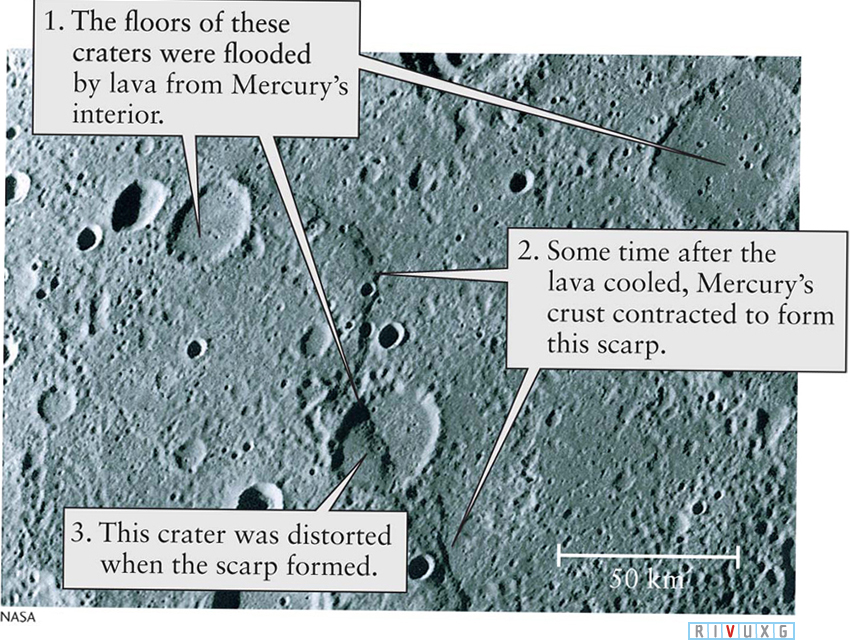
Figure 6-39  Scarps on Mercury A long, meandering cliff, called Santa Maria Rupes, runs from north to south across this Mariner 10 image of a region near Mercury’s equator. This cliff, called a scarp by geologists, is more than 1 km (0.6 mi) high and runs for several hundred kilometers. Note how the crater below the center of the image was distorted vertically when the scarp formed.
Scarps on Mercury A long, meandering cliff, called Santa Maria Rupes, runs from north to south across this Mariner 10 image of a region near Mercury’s equator. This cliff, called a scarp by geologists, is more than 1 km (0.6 mi) high and runs for several hundred kilometers. Note how the crater below the center of the image was distorted vertically when the scarp formed.
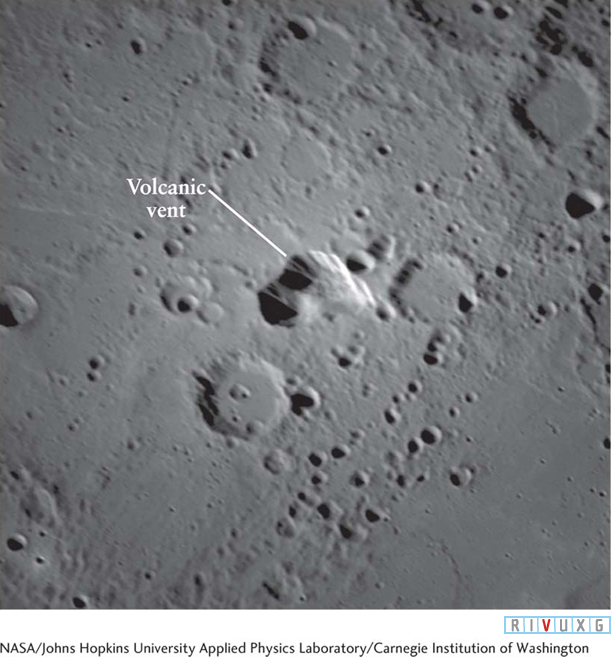
Figure 6-38  Possible Volcanic Vent The central indentation in this Messenger image from 2009 is believed to be a caldera (sunken vent) of an explosive volcano on Mercury. It is unlikely to be an impact crater, as it completely lacks a raised crater wall.
Possible Volcanic Vent The central indentation in this Messenger image from 2009 is believed to be a caldera (sunken vent) of an explosive volcano on Mercury. It is unlikely to be an impact crater, as it completely lacks a raised crater wall.
Focus Question 6-10
The rings of mountains frozen into Mercury’s and the Moon’s surfaces have what transient analog on Earth? (Hint: Think about impacts.)
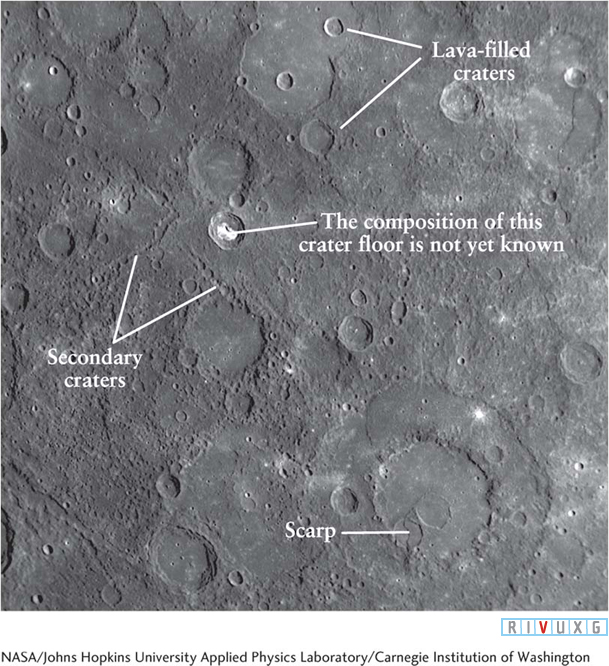
Figure 6-40  Geology on Mercury This Messenger image shows a variety of interesting features, including lava-filled craters, secondary craters created by debris that splashed out of an impact crater, a scarp cutting through an old crater, and as yet unidentified, light-colored rock at the bottom of a crater.
Geology on Mercury This Messenger image shows a variety of interesting features, including lava-filled craters, secondary craters created by debris that splashed out of an impact crater, a scarp cutting through an old crater, and as yet unidentified, light-colored rock at the bottom of a crater.
Dormant volcanoes were discovered on Mercury in 2008 (Figure 6-38) by the Messenger spacecraft. Some of the material creating the Mercurian plains came from such volcanoes, while the rest came through craters created as large meteorites punctured the planet’s thin, newly formed crust, allowing lava to well up from the molten interior to flood low-lying areas. The existence of craters on Mercury’s plains suggests that these features formed just over 3.8 billion years ago, near the end of the Late Heavy Bombardment. Mercury’s plains are therefore older than most of the lunar maria, leaving more time for cratering to occur on Mercury. Today, 40% of Mercury’s surface is covered by these plains, while the rest is more heavily cratered.
Mariner 10 and Messenger also revealed numerous long cliffs, called scarps, meandering across Mercury’s surface (Figure 6-39). Recall that they have also been observed on our Moon (see Figure 6-28). Just as occurred on our Moon (Section 6-7), scarps are believed to have developed as Mercury cooled, suggesting that the planet’s interior is solid to a significant depth. Otherwise, lava would have leaked out as the scarps formed.
Messenger continues to provide intriguing images of Mercury. Figure 6-40 is one of the most interesting photos taken so far. The features displayed in this photograph include lines of secondary craters, created by ejecta from impacts; craters filled with volcanic lava; a large impact crater (diameter of 210 km [130 mi]) and concentric ring created as a ripple of surface rock by the impact, both of which are filled in with lava; a scarp; and a crater with as yet unexplained light rock revealed inside it. The large double-ringed crater is a smaller version of Caloris Basin.
6-12 Mercury has a higher percentage of iron than Earth
Mercury’s average density of 5430 kg/m3 (4.15 tons/yd3) is quite similar to Earth’s (5520 kg/m3 or 4.22 tons/yd3). As we saw in Section 6-4, typical rocks on Earth’s surface have a density of only about 3000 kg/m3 (2.3 tons/yd3) because they are composed primarily of lightweight elements. The high average densities of both Mercury and our planet are caused by their dense interiors.
Because Mercury is less dense than Earth, you might conclude that Mercury has a lower percentage of iron, a common heavy element, than does our planet. Indeed, Messenger revealed that Mercury’s surface has a low iron content. However, in terms of the percentage of its total mass that is iron, Mercury is the most iron-rich planet in the solar system. Only Earth’s greater mass, pressing inward and thereby compressing our planet’s inner parts, makes it denser than Mercury. Figure 6-41 shows a scale drawing of Mercury’s interior, where an iron core contains nearly 60% of the planet’s mass and 75% of its radius. Surrounding the core is a rocky mantle 600 km (375 mi) thick. For comparison, Earth’s iron core contains only 32.5% of Earth’s mass and it extends out to only 55% of our planet’s radius.
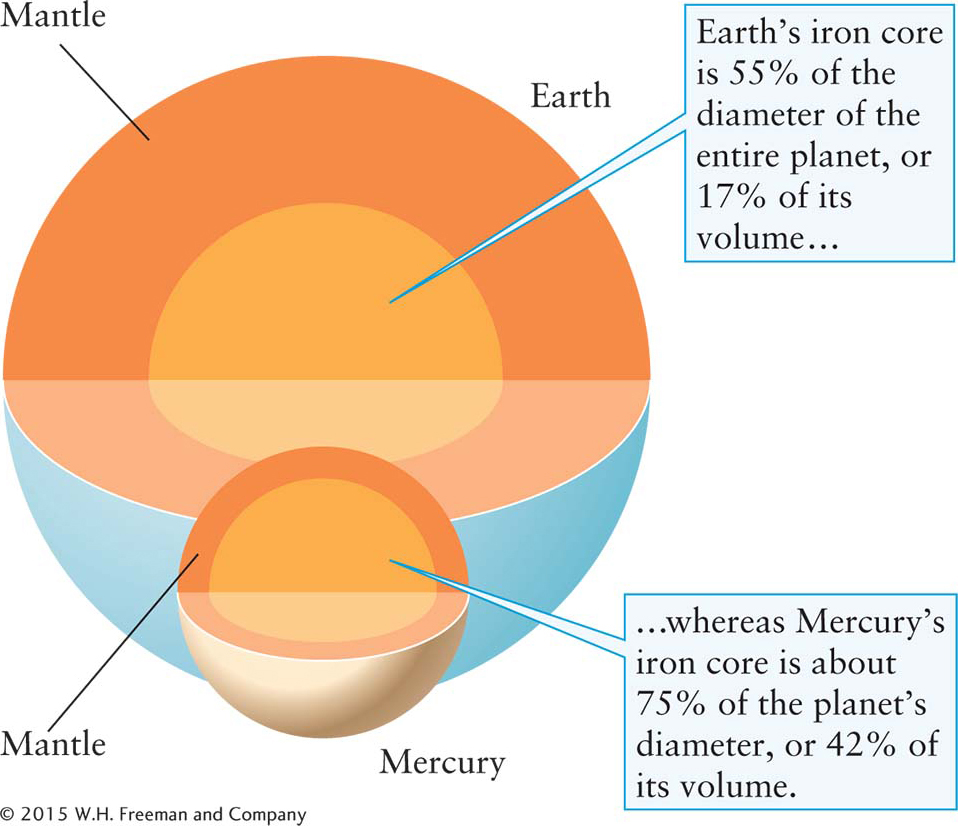
Figure 6-41 The Interiors of Earth and Mercury Mercury has the highest percentage of iron of any planet in the solar system. Consequently, its iron core occupies an exceptionally large fraction of its interior.
Mariner 10 discovered that Mercury has a varying magnetic field about 1% as strong as that of Earth. The field, aligned with Mercury’s rotation axis, sometimes interacts with the solar wind (Figure 6-42) more weakly than does Earth’s field, and sometimes more strongly (recall Section 6-5). Indeed, scientists have observed Mercury’s field changing significantly over just a few years. The cause of the change is still unknown. Until 2008, astronomers did not even know what generated Mercury’s magnetic field. In that year, the Messenger spacecraft passing by Mercury revealed that part of the planet’s core is molten. As we saw in Section 6-5, electric currents in a planet’s liquid iron core create a planetwide magnetic field. Earth creates its electric current by rotating once a day. Mercury rotates 59 times more slowly. That slower rotation and the lower volume of molten iron inside Mercury (compared to Earth) explain why Mercury’s magnetic field is so weak.

Figure 6-42 Mercury’s Magnetosphere Mercury’s magnetic field is about 1% as strong as Earth’s field, just strong enough to deflect the solar wind.
Events early in Mercury’s history must somehow account for its high iron content. We know that the inner regions of the primordial solar nebula were incredibly hot. Perhaps only iron-rich minerals were able to withstand the solar heat there, and these subsequently formed iron-rich Mercury. According to another theory, an especially intense outflow of particles from the young Sun stripped Mercury of its low-density mantle shortly after the Sun formed. A third possibility is that, during the final stages of planet formation, Mercury may have been struck by a large planetesimal (debris formed as the solar system came into being), just as Earth was struck by a Mars-sized body that led to the formation of our Moon. Computer simulations show that this cataclysmic collision would have ejected much of Mercury’s lighter mantle (Figure 6-43). Such an impact could also help explain Mercury’s significantly elliptical orbit; however, this theory is still being explored.

Figure 6-43 The Stripping of Mercury’s Mantle To account for Mercury’s high iron content, one theory proposes that a collision with a massive planetesimal stripped Mercury of most of its rocky mantle. These three images show a computer simulation of a nearly head-on collision between proto-Mercury and a body one-sixth its mass. Both worlds are shattered by the impact, which vaporizes much of their rocky mantles. Mercury eventually reforms from the remaining iron-rich debris. The rest of the original Mercury and the impactor leave this area of the solar system.
6-13 Mercury’s rotation and revolution are coupled
Focus Question 6-11
If Mercury were struck by a large planetesimal, why would this collision not produce a moon, as happened when Earth was struck early in its history?
Mercury has one of the most unusual orbits in the solar system. Recall from Section 6-9 that when Earth was young, its gravitational force created tides on the Moon, thereby forcing the Moon into synchronous rotation. Something similar (but not identical) happened with the Sun playing the role of Earth and Mercury acting in the place of our Moon. To begin with, the Sun’s gravity produced two significant tidal bulges on opposite sides of young, molten Mercury. Mercury is so close to the Sun (average separation 0.387 AU) that the Sun’s gravitational force on Mercury’s tidal bulges changed the planet’s rotation rate before its surface solidified, with the two regions of high tide now locked into place on the planet. However, Mercury’s highly eccentric orbit (e = 0.21) prevented the planet from being locked into synchronous orbit like our Moon. Instead, Mercury developed what is called a 3-to-2 spin-orbit coupling. This coupling means that Mercury undergoes three sidereal rotations (rotations measured with respect to the distant stars, not the Sun), while undergoing two revolutions around the Sun (Figure 6-44).

Figure 6-44 3-to-2 Spin-Orbit Coupling Mercury undergoes three sidereal rotations every 2 years. You can see this by following the flag on Mercury (a) from timestep 1 to timestep 15 and then (b) from timestep 15 to timestep 29. The flag points to the right four times during this interval (at times 1, 10, 20, and, finally, at 29). This means that Mercury has rotated 3 times in exactly 2 sidereal Mercurian years. Because a sidereal year is 88 Earth days long, a sidereal day on Mercury is 58.7 Earth days long. During the same interval, however, the Sun is at noon as seen from the flag’s location only twice: at timestep 1 and timestep 29. Therefore, a solar day is 176 Earth days long.
The major consequence of spin-orbit coupling is that one or the other of Mercury’s regions of high tide is facing the Sun whenever the planet is at perihelion (see Figure 6-44).
A day on Mercury is 2 Mercury years longThe motion of the Sun across Mercury’s sky is unique in the solar system. First, a solar day there (noon to noon) is 176 Earth days long, twice the length of a year on Mercury! Furthermore, if you were to set up a camera at the location of high tide on Mercury to take a series of pictures, you would see the Sun start to rise in the east, stop high in the sky, move back toward the east, stop again, and then resume its westward journey. This is analogous to the retrograde motion of the planets that we observe from Earth (see Section 2-2).
Just as astronomers use scattered radio waves to search for water on the Moon (see Section 6-7), they have also sent radio waves to Mercury. In 1992, researchers made an extraordinary discovery—evidence for ice near Mercury’s poles in craters that are permanently in shadow. Dozens of circular regions, now known to be craters, sent back signals with characteristics distinct to ice. The presence of this ice was confirmed by the Messenger spacecraft. The origin of the ice—whether from cometary impacts, from gases rising from inside the planet and then freezing, or from both sources—remains to be determined.
Insight Into Science
Model Building In modeling real situations, scientists must consider several different effects simultaneously. Omit any crucial property and you get inaccurate results. For example, consider how long ice can remain at Mercury’s poles. Astronomers must take into account the planet’s distance from the Sun, the tilt of its axis of rotation, its rotation rate, its surface features, its chemical composition, its atmosphere, and whether the ice on it is exposed or mixed with other material.
6-14 Mercury’s atmosphere is the thinnest of all terrestrial planets
Focus Question 6-12
Why isn’t Mercury in synchronous rotation with respect to the Sun?
Mercury’s mass is only 5.5% that of Earth. Like our Moon, the force of gravity is too weak on Mercury to hold a permanent atmosphere, but trace amounts of seven different gases—hydrogen, helium, sodium, calcium, magnesium, potassium, and oxygen—have been detected around Mercury. These gases are at least 1017 times less dense than the air we breathe. Scientists think the Sun is the source of the hydrogen and helium gas near Mercury, while sodium, magnesium, calcium, and potassium gases escape from rocks inside the planet (a process called outgassing, which also occurs on Earth). Different concentrations of these gases were observed at different locations over the planet. Oxygen observed in Mercury’s atmosphere may come from polar ice that is slowly sublimating. (Technically, when a solid, like ice, is transformed directly into a gas phase, the term is sublimation.) Impact of space debris also adds gases to the atmosphere. All of these gases drift into space and are continually replenished in the atmosphere from their respective sources. The radiation and particles flowing out of the Sun are pushing much of this gas outward, creating a tail for Mercury pointing away from the Sun. This tail is analogous to comet tails created by the Sun.
 Mercury’s temperature range is the most extreme in the solar systemEarth’s thick atmosphere stores heat, which helps explain why it stays warm on cloudy days and at night. Nevertheless, Earth continually loses heat into space. Because of Earth’s rapid daily rotation, this lost heat is quickly replaced by the Sun during daylight hours, so the average temperature change between day and night on Earth is only about 11 K (20°F). Mercury’s slow rotation and its nearly complete lack of an atmosphere cause the difference in temperatures between day and night there to be far greater than on Earth. At noon on Mercury, the surface temperature is 700 K (800°F). At the terminator, where day meets night, the temperature is about 425 K (305°F). On the night side, shortly before sunrise, the temperature falls to as low as 100 K (−280°F), the coldest temperature on any terrestrial planet! The resulting daily range of temperature on Mercury is therefore 600 K (1080°F).
Mercury’s temperature range is the most extreme in the solar systemEarth’s thick atmosphere stores heat, which helps explain why it stays warm on cloudy days and at night. Nevertheless, Earth continually loses heat into space. Because of Earth’s rapid daily rotation, this lost heat is quickly replaced by the Sun during daylight hours, so the average temperature change between day and night on Earth is only about 11 K (20°F). Mercury’s slow rotation and its nearly complete lack of an atmosphere cause the difference in temperatures between day and night there to be far greater than on Earth. At noon on Mercury, the surface temperature is 700 K (800°F). At the terminator, where day meets night, the temperature is about 425 K (305°F). On the night side, shortly before sunrise, the temperature falls to as low as 100 K (−280°F), the coldest temperature on any terrestrial planet! The resulting daily range of temperature on Mercury is therefore 600 K (1080°F).











 Mercury’s temperature range is the most extreme in the solar systemEarth’s thick atmosphere stores heat, which helps explain why it stays warm on cloudy days and at night. Nevertheless, Earth continually loses heat into space. Because of Earth’s rapid daily rotation, this lost heat is quickly replaced by the Sun during daylight hours, so the average temperature change between day and night on Earth is only about 11 K (20°F). Mercury’s slow rotation and its nearly complete lack of an atmosphere cause the difference in temperatures between day and night there to be far greater than on Earth. At noon on Mercury, the surface temperature is 700 K (800°F). At the terminator, where day meets night, the temperature is about 425 K (305°F). On the night side, shortly before sunrise, the temperature falls to as low as 100 K (−280°F), the coldest temperature on any terrestrial planet! The resulting daily range of temperature on Mercury is therefore 600 K (1080°F).
Mercury’s temperature range is the most extreme in the solar systemEarth’s thick atmosphere stores heat, which helps explain why it stays warm on cloudy days and at night. Nevertheless, Earth continually loses heat into space. Because of Earth’s rapid daily rotation, this lost heat is quickly replaced by the Sun during daylight hours, so the average temperature change between day and night on Earth is only about 11 K (20°F). Mercury’s slow rotation and its nearly complete lack of an atmosphere cause the difference in temperatures between day and night there to be far greater than on Earth. At noon on Mercury, the surface temperature is 700 K (800°F). At the terminator, where day meets night, the temperature is about 425 K (305°F). On the night side, shortly before sunrise, the temperature falls to as low as 100 K (−280°F), the coldest temperature on any terrestrial planet! The resulting daily range of temperature on Mercury is therefore 600 K (1080°F). Mercury and the Far Side of Our Moon Mercury and our Moon are shown here to the same size scale. Mercury’s radius is 2439 km (1515 mi) and the Moon’s is 1738 km (1080 mi). For comparison, the distance from New York to Los Angeles is 3944 km (2451 mi). Mercury’s surface is more uniformly cratered than that of the Moon. Daytime temperatures at the equator on Mercury reach 700 K (800°F), hot enough to melt lead or tin.
Mercury and the Far Side of Our Moon Mercury and our Moon are shown here to the same size scale. Mercury’s radius is 2439 km (1515 mi) and the Moon’s is 1738 km (1080 mi). For comparison, the distance from New York to Los Angeles is 3944 km (2451 mi). Mercury’s surface is more uniformly cratered than that of the Moon. Daytime temperatures at the equator on Mercury reach 700 K (800°F), hot enough to melt lead or tin.